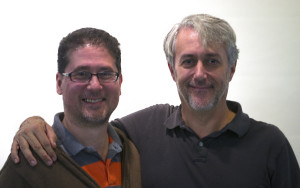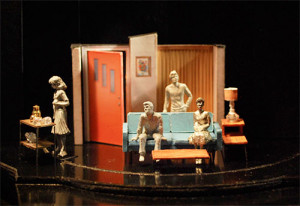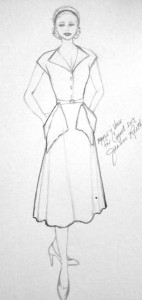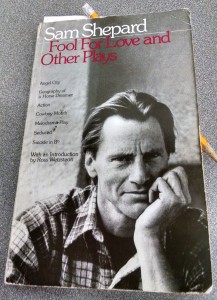“Shep Rep” Survival Guide
Here at Cygnet Theatre, we affectionately call our next two shows, Fool for Love & True West, by Sam Shepard the “ShepRep”. Our dramaturg, Taylor Wycoff, is here to help you prepare for your upcoming visit to our theatre with a bit of insight into what exactly this whole ShepRep thing is…
What does “in repertory” mean?
When a theatre company says that they are producing two or more production “in repertory” it simply means that they are presenting several plays from their repertoire, usually in alternation or rotation. This can take on a variety of forms – for us it means we are presenting two related plays that alternate every night.
“The themes of family and the American Dream are universal, but few writers attack them so dramatically and brilliantly as Shepard.”
– Sean Murray, Artistic Director
What is the benefit of doing two shows in rep?
The idea behind the repertory part of our season is to give the audience the opportunity to see two related shows back-to-back, enhancing the experience of the plays and understanding of the themes. Last year we gave you two very different shows that shared some of the same characters, Oscar Wilde’s The Importance of Being Earnest and the subsequently inspired Travesties by Tom Stoppard. This year we are excited to again share two very different shows that this time share the same playwright, Sam Shepard
Why these plays?
Sam Shepard is often cited as one of the greatest American playwrights, along with likes of Arthur Miller, Tennessee Williams, and Eugene O’Neill. His plays tend to explore themes of love, loss and dysfunctional family life and are often set in gritty small towns and the open spaces of the American West. Other than that, Shepard’s plays are difficult to categorize except for the fact that they blend unanticipated humor and beauty with brutal honesty and painful relationships. In selecting these two plays, Cygnet’s Artist Director, Sean Murray, wanted to give the audience two very distinct lenses through which to view Sam Shepard and his work. That being said and despite one show being about two brothers and the other about two lovers, having the opportunity to see both productions in such proximity will help you find those connections, providing for a much more involved and exciting theatre experience!
Bringing back the 50s with director Igor Goldin
Thanks to the miracles of modern technology, last month we were able to Skype with Maple and Vine director Igor Goldin from his New York apartment where he was working on a new musical. He provided some very interesting insights about the process of bringing the new comedy to the Cygnet Theatre stage. Maple and Vine by Jordan Harrison, runs January 16 through February 16.
CT: This is your first time directing at Cygnet Theatre. How did you get connected?

I was in San Diego directing for Diversionary Theatre and had a chance to see several productions and fell in love with Cygnet. I saw Cabaret and It’s a Wonderful Life: A Live Radio Play and loved the creativity and specificity in which they were performed and directed. I also had seen a Caryl Churchill play produced years ago at the Rolando Stage, A Number, and was extremely impressed with the texture and gray areas in the piece and how it didn’t spoon feed the audience, but trusted them to come up with their own answers. Sean [Murray] and I went to North Carolina School of the Arts together. He saw my production of Yank! and thought of me when they put Maple and Vine on the season. We had both wanted to work with each other for some time so I’m thrilled that it worked out with Maple and Vine.
CT: Maple and Vine is about a modern day couple who choose to leave the big city and move to a gated community where the residents live like it’s 1955. How will you present these opposing settings?

I’ve been skyping with set director Sean Fanning and we are both excited about the addition of a turntable to the Cygnet stage. The structure of the play is very episodic with short scenes involving quick scenic, costume and lighting changes. The turntable provides an opportunity to shift eras and locations quickly and keep the show fluid. It’s a dark comedy that deals with important social issues and I’m certain audiences will debate them after the show, but during the performance, it’s important to keep things moving, with each scene flowing seamlessly into the next.
CT: What about the look and feel? How are you working with designers to create both eras?
We are limited by the resources and economy of a nonprofit theater, but that is a challenge I rather enjoy. I’d much rather solve problems creatively within constraints than have a bloated budget and throw everything at the audience. We’ll be working with simple iconic set pieces that are clearly grounded in the era they represent. In fact, the concept of limited resources is one that resonates within the play because going back to the 50s means we don’t have everything at our fingertips as we do today

I’m also working with costume designer Jeanne Reith to capture the quality and specificity of each era. The 1950’s Ozzie and Harriet/Leave it to Beaver look has a warm and cozy feel, while the urban sleek style of today’s New York has a totally different feel. We’ll also be working with a variety of rigging solutions for quick changes. The lighting and scenery will define the 2 eras with a sleek, angular, urban starkness for 2011 to a saturated, warmer and softer look for 1955.
CT: The comedy looks at attitudes about gender, race and sexuality. What is it “really” about for you?
It’s a light but penetrating comedy that explores what happens when we are stripped of the liberties of this world and forced to live within the narrow social structure of 1955. In the 50s there is a veneer of contentment that cloaks what’s lurking underneath. It’s about what we are hoping to reclaim within ourselves by living in a world with less freedom and equality, what we are willing to walk away from and what we lose and gain through the process. It about what it means to live your life authentically.
CT: What would you miss most if you had to return to the 1950?
My freedom as a gay man.
CT: What would you miss the least?
The constant bombardment of information and the false sense of connectivity and accessibility that we get with our hand held devices and social media.
